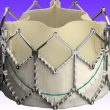Courtesy of Dr. Carlos Fava. Aortic stenosis with cardiac failure or cardiogenic shock involves high mortality risk at short term. Surgery in these conditions is often unsafe, which leaves us with valvuloplasty, but only as a bridge to some other procedure, seeing as it is effective only for a short time. Few studies have looked into patients undergoing...
CTO Revascularization Improves Quality of Life
Courtesy of Dr. Carlos Fava. The presence of CTO hovers around 15, 20% in coronary angiographies of patients with chronic stable angina, but only 5% receive percutaneous coronary intervention (PCI). One of the obstacles to percutaneous revascularization is the lack of relevant studies justifying it, though we do have different comparative studies that improve symptoms, ventricular...
Liver Failure as a Challenge for TAVR
Although surgical risk scores do not include liver failure (LF), patients who suffer from it and undergo cardiovascular surgery present high rates of morbidity and mortality. This is due to alteration of cardiac function, increased infection susceptibility, gastrointestinal complications, and increased bleeding. As regards transcatheter aortic valve replacement (TAVR), these patients have not been included...
Bicuspid Valves Do Not Increase Mortality in TAVR
The frequency of bicuspid aortic valves (BcAV) are around 1%, but in 60+ patients it is associated to severe aortic stenosis. Even though surgery is the standard treatment, TAVR is the “off label” indication in high risk patients. BcAV presents differences with tricuspids given that it is more elliptic, has asymmetric calcification and more...
Diastolic Dysfunction Should Be Considered in TAVR
Aortic stenosis increases afterload creating hypertrophy as a compensation mechanism to maintain minute volume. This leads to left ventricular diastolic dysfunction (LVDD). More than half of patients presenting aortic stenosis have LVDD and myocardial fibrosis, which is a mortality predictor in surgery. At present, there is contradicting evidence in TAVR. The study looked...
WIN TAVI: The Largest Female TAVR Registry So Far
Courtesy of Dr. Carlos Fava. In most randomized or observational studies, women comprise more than 50% of patients undergoing TAVR, and they have showed better evolution, compared against surgery. The main differences between men and women with severe aortic stenosis are that women have smaller annular dimension, shorter distance to coronary ostia, smaller peripheral arteries, and...
Does a Combination of Diabetes and Acute Coronary Syndrome Change the Revascularization Strategy?
The results of the FREEDOM (Future Revascularization Evaluation in Patients With Diabetes Mellitus: Optimal Management of Multi-vessel Disease) trial have shown a lower rate of events in patients with diabetes and stable multivessel disease who were randomized to undergo myocardial revascularization surgery, compared to those who underwent angioplasty. Surgery even showed a mortality reduction that...
Coronary Angioplasty Is a Valid Alternative for Left Main Coronary Artery Disease
Courtesy of Dr. Carlos Fava. Severe left main coronary artery (LMCA) lesions have a bad prognosis in coronary disease. In that scenario, current guidelines recommend surgery as the treatment of choice. However, due to the current development of second-generation drug-eluting stents (DES) and greater operator expertise, left main coronary artery angioplasty appears as a valid alternative...
TAVR in Pure Aortic Regurgitation: New Devices, New Outcomes
Pure aortic regurgitation has historically been considered a contraindication for transcatheter aortic valve replacement (TAVR) due to the absence of calcification and subsequent device anchoring problems it poses. Initial reports on first-generation self-expanding valves for the treatment of pure regurgitation were somewhat discouraging, but devices evolved, adding repositioning capacity, different external skirts (pericardial, PET, urethane,...
Failing Surgical Bioprosthesis: A Challenge on the Rise
Courtesy of Dr. Carlos Fava. The gold standard for failing aortic bioprosthesis has traditionally been surgery. However, since the first valve in valve (TAV-in-SAV) report in 2007, by Wenaweser, transcatheter valve implantation has emerged as a valid alternative. Even so, at present there is not enough scientific evidence in this regard. The present study analyzed...









